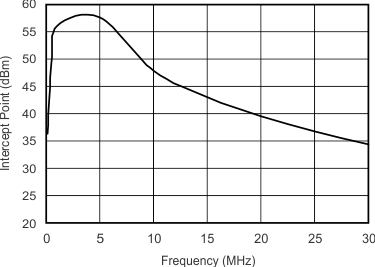SBOS431A May 2009 – March 2017 THS6214
PRODUCTION DATA.
- 1 Features
- 2 Applications
- 3 Description
- 4 Revision History
- 5 Pin Configuration and Functions
-
6 Specifications
- 6.1 Absolute Maximum Ratings
- 6.2 ESD Ratings
- 6.3 Recommended Operating Conditions
- 6.4 Thermal Information
- 6.5 Electrical Characteristics: VS = ±12 V
- 6.6 Electrical Characteristics: VS = ±6 V
- 6.7 Timing Requirements
- 6.8 Typical Characteristics: VS = ±12 V, Full Bias
- 6.9 Typical Characteristics: VS = ±12 V, Mid Bias
- 6.10 Typical Characteristics: VS = ±12 V, Low Bias
- 6.11 Typical Characteristics: VS = ±6 V, Full Bias
- 6.12 Typical Characteristics: VS = ±6 V, Mid Bias
- 6.13 Typical Characteristics: VS = ±6 V, Low Bias
- 7 Detailed Description
- 8 Application and Implementation
- 9 Power Supply Recommendations
- 10Layout
- 11Device and Documentation Support
- 12Mechanical, Packaging, and Orderable Information
Package Options
Mechanical Data (Package|Pins)
Thermal pad, mechanical data (Package|Pins)
- PWP|24
Orderable Information
6 Specifications
6.1 Absolute Maximum Ratings
over operating free-air temperature range (unless otherwise noted)(1)| MIN | MAX | UNIT | ||
|---|---|---|---|---|
| Supply voltage, VS– to VS+ | 28 | V | ||
| Input voltage, VI | ±VS | V | ||
| Differential input voltage, VID | ±2 | V | ||
| Output current, IO | Static dc(2) | ±500 | mA | |
| Continuous power dissipation | See Thermal Information | |||
| Maximum junction temperature, TJ | Under any condition(3) | 150 | °C | |
| Continuous operation, long-term reliability(4), RHF package only | 130 | |||
| Continuous operation, long-term reliability(4), PWP package only | 140 | |||
| Storage temperature, Tstg | –65 | 150 | °C | |
(1) Stresses beyond those listed under Absolute Maximum Ratings may cause permanent damage to the device. These are stress ratings only, which do not imply functional operation of the device at these or any other conditions beyond those indicated under Recommended Operating Conditions. Exposure to absolute-maximum-rated conditions for extended periods may affect device reliability.
(2) The THS6214 incorporates a PowerPAD on the underside of the chip. This pad functions as a heatsink and must be connected to a thermally dissipating plane for proper power dissipation. Failure to do so may result in exceeding the maximum junction temperature, which can permanently damage the device. See PowerPAD™ Thermally Enhanced Package (SLMA002) for more information about using the PowerPAD thermally-enhanced package. Under high-frequency ac operation (greater than 10 kHz), the short-term output current capability is much greater than the continuous dc output current rating. This short-term output current rating is approximately 8.5 times the dc capability, or approximately ±850 mA.
(3) The absolute maximum junction temperature under any condition is limited by the constraints of the silicon process.
(4) The absolute maximum junction temperature for continuous operation is limited by the package constraints. Operation above this temperature may result in reduced reliability and/or lifetime of the device.
6.2 ESD Ratings
| VALUE | UNIT | |||
|---|---|---|---|---|
| V(ESD) | Electrostatic discharge | Human-body model (HBM), per ANSI/ESDA/JEDEC JS-001(1) | ±2000 | V |
| Charged-device model (CDM), per JEDEC specification JESD22-C101(2) | ±500 | |||
| Machine model (MM) | ±100 | |||
(1) JEDEC document JEP155 states that 500-V HBM allows safe manufacturing with a standard ESD control process.
(2) JEDEC document JEP157 states that 250-V CDM allows safe manufacturing with a standard ESD control process.
6.3 Recommended Operating Conditions
over operating free-air temperature range (unless otherwise noted)| MIN | NOM | MAX | UNIT | ||
|---|---|---|---|---|---|
| VS | Supply voltage, VS– to VS+ | 10 | 28 | V | |
| TJ | Operating junction temperature | 130 | °C | ||
| TA | Ambient operating air temperature | 25 | 85 | °C | |
6.4 Thermal Information
| THERMAL METRIC(1) | THS6214 | UNIT | ||
|---|---|---|---|---|
| RHF (VQFN) | PWP (HTSSOP) | |||
| 24 PINS | 24 PINS | |||
| RθJA | Junction-to-ambient thermal resistance | 33.2 | 35.7 | °C/W |
| RθJC(top) | Junction-to-case (top) thermal resistance | 31.7 | 22.9 | °C/W |
| RθJB | Junction-to-board thermal resistance | 11.3 | 10.1 | °C/W |
| ψJT | Junction-to-top characterization parameter | 0.4 | 0.4 | °C/W |
| ψJB | Junction-to-board characterization parameter | 11.3 | 10.3 | °C/W |
| RθJC(bot) | Junction-to-case (bottom) thermal resistance | 3.9 | 1.7 | °C/W |
(1) For more information about traditional and new thermal metrics, see the Semiconductor and IC Package Thermal Metrics application report.
6.5 Electrical Characteristics: VS = ±12 V
at TA = 25°C, GDIFF = 10 V/V with RL = 100-Ω differential load, RADJ = 0 Ω, active impedance circuit configuration, and full bias (unless otherwise noted); each port is independently tested| PARAMETER | TEST CONDITIONS | MIN | TYP | MAX | UNIT | TEST LEVEL(1) | |||
|---|---|---|---|---|---|---|---|---|---|
| AC PERFORMANCE | |||||||||
| Small-signal bandwidth, –3 dB | GDIFF = 5 V/V , RF = 1.5 kΩ, VO = 2 VPP | 160 | MHz | C | |||||
| GDIFF = 10 V/V , RF = 1.5 kΩ, VO = 2 VPP | 120 | 150 | B | ||||||
| Over –40°C to +85°C temperature range | 100 | ||||||||
| 0.1-dB bandwidth flatness | GDIFF = 10 V/V , RF = 1.24 kΩ | 114 | MHz | C | |||||
| Large-signal bandwidth | GDIFF = 10 V/V , RF = 1.24 kΩ, VO = 20 VPP | 120 | MHz | C | |||||
| Slew rate (10% to 90% level) | GDIFF = 10 V/V, VO = 20-V step, differential | 3200 | 3800 | V/µs | B | ||||
| TA = –40°C to +85°C | 3000 | B | |||||||
| Rise and fall time | GDIFF = 10 V/V, VO = 2 VPP | 5 | ns | C | |||||
| 2nd-order harmonic distortion | GDIFF = 10 V/V, VO = 2 VPP, RL = 100-Ω differential |
Full bias, f = 1 MHz | –100 | –95 | dBc | B | |||
| TA = –40°C to +85°C | –90 | B | |||||||
| Low bias, f = 1 MHz | –96 | C | |||||||
| Full bias, f = 10 MHz | –75 | –70 | B | ||||||
| TA = –40°C to +85°C | –65 | B | |||||||
| Low bias, f = 10 MHz | –72 | C | |||||||
| 3rd-order harmonic distortion | GDIFF = 10 V/V, VO = 2 VPP, RL = 100-Ω differential |
Full bias, f = 1 MHz | –89 | –85 | dBc | B | |||
| TA = –40°C to +85°C | –80 | B | |||||||
| Low bias, f = 1 MHz | –85 | C | |||||||
| Full bias, f = 10 MHz | –73 | –65 | B | ||||||
| TA = –40°C to +85°C | –53 | B | |||||||
| Low bias, f = 10 MHz | –58 | C | |||||||
| Differential input voltage noise | f = 1 MHz, input-referred | 2.7 | 3.2 | nV/√Hz | B | ||||
| TA = –40°C to +85°C | 3.5 | B | |||||||
| Differential noninverting current noise | f = 1 MHz | 1.2 | 1.4 | pA/√Hz | B | ||||
| TA = –40°C to +85°C | 1.6 | B | |||||||
| Differential inverting current noise | f = 1 MHz | 17 | 20 | pA/√Hz | B | ||||
| TA = –40°C to +85°C | 24 | B | |||||||
| DC PERFORMANCE | |||||||||
| Open-loop transimpedance gain | RL = 100 Ω | 330(4) | 700 | kΩ | A | ||||
| 300 | B | ||||||||
| Input offset voltage | ±15 | ±50(4) | mV | A | |||||
| TA = –40°C to +85°C | ±60 | B | |||||||
| Input offset voltage drift | TA = –40°C to +85°C | ±155 | µV/°C | B | |||||
| Input offset voltage matching | ±0.5 | ±5(4) | mV | A | |||||
| TA = –40°C to +85°C | ±7 | B | |||||||
| Noninverting input bias current | ±1 | ±3.5(4) | µA | A | |||||
| TA = –40°C to +85°C | ±5.5 | B | |||||||
| Noninverting input bias current drift | TA = –40°C to +85°C | ±30(4) | nA/°C | B | |||||
| Inverting input bias current | ±8 | ±45(4) | µA | A | |||||
| TA = –40°C to +85°C | ±55 | B | |||||||
| Inverting input bias current drift | TA = –40°C to +85°C | ±154 | nA/°C | B | |||||
| Inverting input bias current matching | ±8 | ±30(4) | µA | A | |||||
| TA = –40°C to +85°C | ±40 | B | |||||||
| INPUT CHARACTERISTICS | |||||||||
| Common-mode input range | Each input | ±9(4) | ±9.5 | V | A | ||||
| TA = –40°C to +85°C | ±8.6 | B | |||||||
| Common-mode rejection ratio | Each input | 53(4) | 65 | dB | A | ||||
| TA = –40°C to +85°C | 49 | B | |||||||
| Noninverting input resistance | 500 || 2 | kΩ || pF | C | ||||||
| Inverting input resistance | 50 | Ω | C | ||||||
| OUTPUT CHARACTERISTICS(2) | |||||||||
| Output voltage swing | RL = 100 Ω, each output | ±10.9 | V | C | |||||
| RL = 50 Ω, each output | ±10.6(4) | ±10.8 | A | ||||||
| TA = –40°C to +85°C | ±10.4 | B | |||||||
| RL = 25 Ω, each output | ±10.2(4) | ±10.4 | A | ||||||
| TA = –40°C to +85°C | ±10 | B | |||||||
| Output current (sourcing and sinking) |
RL = 25 Ω, based on VO tests | ±408(4) | ±416 | mA | A | ||||
| TA = –40°C to +85°C | ±400 | B | |||||||
| Short-circuit output current | 1 | A | C | ||||||
| Output impedance | f = 1 MHz, differential | 0.2 | Ω | C | |||||
| Crosstalk | f = 1 MHz, VO = 2 VPP, port 1 to port 2 | –90 | dB | C | |||||
| POWER SUPPLY | |||||||||
| Operating voltage | ±5(4) | ±12 | ±14(4) | V | A | ||||
| TA = –40°C to +85°C | ±5 | ±14 | C | ||||||
| IS+ quiescent current | Per port, full bias (BIAS-1 = 0, BIAS-2 = 0) | 19.5(4) | 21 | 22.5(4) | mA | A | |||
| TA = –40°C to +85°C | 17 | 24 | B | ||||||
| Per port, mid bias (BIAS-1 = 1, BIAS-2 = 0) | 15(4) | 16.2 | 17.4(4) | A | |||||
| TA = –40°C to +85°C | 12.8 | 18.6 | B | ||||||
| Per port, low bias (BIAS-1 = 0, BIAS-2 = 1) | 10(4) | 11.2 | 12.4(4) | A | |||||
| TA = –40°C to +85°C | 8.1 | 13.2 | B | ||||||
| Per port, bias off (BIAS-1 = 1, BIAS-2 = 1) | 0.4 | 0.8(4) | A | ||||||
| TA = –40°C to +85°C | 1 | B | |||||||
| IS– quiescent current | Per port, full bias (BIAS-1 = 0, BIAS-2 = 0) | 18.5(4) | 20 | 21.5(4) | mA | A | |||
| TA = –40°C to +85°C | 16 | 23 | B | ||||||
| Per port, mid bias (BIAS-1 = 1, BIAS-2 = 0) | 14(4) | 15.2 | 16.4(4) | A | |||||
| TA = –40°C to +85°C | 11.8 | 17.6 | B | ||||||
| Per port, low bias (BIAS-1 = 0, BIAS-2 = 1) | 9(4) | 10.2 | 11.6(4) | A | |||||
| TA = –40°C to +85°C | 7.1 | 11.4 | B | ||||||
| Per port, bias off (BIAS-1 = 1, BIAS-2 = 1) | 0.1 | 0.3(4) | A | ||||||
| TA = –40°C to +85°C | 0.8 | B | |||||||
| Current through GND pin | Per port, full bias (BIAS-1 = 0, BIAS-2 = 0) | 1 | mA | C | |||||
| +PSRR | Positive power-supply rejection ratio | Differential | 54(4) | 66 | dB | A | |||
| TA = –40°C to +85°C | 52 | B | |||||||
| –PSRR | Negative power-supply rejection ratio | Differential | 52(4) | 65 | dB | A | |||
| TA = –40°C to +85°C | 50 | B | |||||||
| LOGIC | |||||||||
| Bias control pin logic threshold | Logic 1, with respect to GND(3), TA = –40°C to +85°C |
1.9 | V | B | |||||
| Logic 0, with respect to GND(3), TA = –40°C to +85°C |
0.8 | B | |||||||
| Bias pin quiescent current | BIAS-1, BIAS-2 = 0.5 V (logic 0) | 20 | 30(4) | µA | A | ||||
| TA = –40°C to +85°C | 35 | B | |||||||
| BIAS-1, BIAS-2 = 3.3 V (logic 1) | 0.3 | 1(4) | A | ||||||
| TA = –40°C to +85°C | 1.2 | B | |||||||
| Bias pin input impedance | 50 | kΩ | C | ||||||
| Amplifier output impedance | Off bias (BIAS-1 = 1, BIAS-2 = 1) | 10 || 5 | kΩ || pF | C | |||||
6.6 Electrical Characteristics: VS = ±6 V
at TA = 25°C, GDIFF = 5 V/V with RL = 100-Ω differential load, RADJ = 0 Ω, active impedance circuit configuration, and full bias (unless otherwise noted); each port is independently tested| PARAMETER | TEST CONDITIONS | MIN | TYP | MAX | UNIT | TEST LEVEL(1) | |||
|---|---|---|---|---|---|---|---|---|---|
| AC PERFORMANCE | |||||||||
| Small-signal bandwidth, –3 dB | GDIFF = 5 V/V , RF = 1.5 kΩ, VO = 2 VPP | 140 | MHz | C | |||||
| GDIFF = 10 V/V , RF = 1.5 kΩ, VO = 2 VPP | 110 | 140 | B | ||||||
| Over –40°C to +85°C temperature range | 95 | ||||||||
| 0.1-dB bandwidth flatness | GDIFF = 10 V/V , RF = 1.24 kΩ | 100 | MHz | C | |||||
| Large-signal bandwidth | GDIFF = 10 V/V , RF = 1.24 kΩ, VO = 20 VPP | 120 | MHz | C | |||||
| Slew rate (10% to 90% level) | GDIFF = 10 V/V, VO = 20-V step, differential | 1200 | 1600 | V/µs | B | ||||
| TA = –40°C to +85°C | 1000 | B | |||||||
| Rise and fall time | GDIFF = 10 V/V, VO = 2 VPP | 5 | ns | C | |||||
| 2nd-order harmonic distortion | GDIFF = 10 V/V, VO = 2 VPP, RL = 100-Ω differential |
Full bias | –98 | –92 | dBc | B | |||
| TA = –40°C to +85°C | –87 | B | |||||||
| Low bias | –93 | C | |||||||
| Full bias | –80 | –75 | B | ||||||
| TA = –40°C to +85°C | –68 | B | |||||||
| Low bias | –74 | C | |||||||
| 3rd-order harmonic distortion | GDIFF = 10 V/V, VO = 2 VPP, RL = 100-Ω differential |
Full bias | –93 | –84 | dBc | B | |||
| TA = –40°C to +85°C | –79 | B | |||||||
| Low bias | –89 | C | |||||||
| Full bias | –66 | –60 | B | ||||||
| TA = –40°C to +85°C | –54 | B | |||||||
| Low bias | –55 | C | |||||||
| Differential input voltage noise | f = 1 MHz, input-referred | 2.5 | 3.0 | nV/√Hz | B | ||||
| TA = –40°C to +85°C | 3.3 | B | |||||||
| Differential noninverting current noise | f = 1 MHz | 1.2 | 1.4 | pA/√Hz | B | ||||
| TA = –40°C to +85°C | 1.6 | B | |||||||
| Differential inverting current noise | f = 1 MHz | 17 | 20 | pA/√Hz | B | ||||
| TA = –40°C to +85°C | 24 | B | |||||||
| DC PERFORMANCE | |||||||||
| Open-loop transimpedance gain | RL = 100 Ω | 330(4) | 650 | kΩ | A | ||||
| TA = –40°C to +85°C | 300 | B | |||||||
| Input offset voltage | ±10 | ±45(4) | mV | A | |||||
| TA = –40°C to +85°C | ±55 | B | |||||||
| Input offset voltage drift | TA = –40°C to +85°C | ±155 | µV/°C | B | |||||
| Input offset voltage matching | Channels 1 to 2 and 3 to 4 only | ±0.5 | ±5(4) | mV | A | ||||
| TA = –40°C to +85°C | ±7 | B | |||||||
| Noninverting input bias current | ±1 | ±3.5(4) | µA | A | |||||
| TA = –40°C to +85°C | ±5.5 | B | |||||||
| Noninverting input bias current drift | TA = –40°C to +85°C | ±30(4) | nA/°C | B | |||||
| Inverting input bias current | ±8 | ±45(4) | µA | A | |||||
| TA = –40°C to +85°C | ±55 | B | |||||||
| Inverting input bias current drift | TA = –40°C to +85°C | ±135 | nA/°C | B | |||||
| Inverting input bias current matching | ±8 | ±30(4) | µA | A | |||||
| TA = –40°C to +85°C | ±40 | B | |||||||
| INPUT CHARACTERISTICS | |||||||||
| Common-mode input range | Each input | ±2.9(4) | ±3.0 | V | A | ||||
| TA = –40°C to +85°C | ±2.7 | B | |||||||
| Common-mode rejection ratio | Each input | 51(4) | 62 | dB | A | ||||
| TA = –40°C to +85°C | 47 | B | |||||||
| Noninverting input resistance | 500 || 2 | kΩ || pF | C | ||||||
| Inverting input resistance | 55 | Ω | C | ||||||
| OUTPUT CHARACTERISTICS(2) | |||||||||
| Output voltage swing | RL = 100 Ω, each output | ±4.9 | V | C | |||||
| RL = 50 Ω, each output | ±4.75(4) | ±4.9 | A | ||||||
| TA = –40°C to +85°C | ±4.6 | B | |||||||
| RL = 25 Ω, each output | ±4.55(4) | ±4.7 | A | ||||||
| TA = –40°C to +85°C | ±4.4 | B | |||||||
| Output current (sourcing and sinking) |
RL = 25 Ω, based on VO tests | ±182(4) | ±188 | mA | A | ||||
| TA = –40°C to +85°C | ±176 | B | |||||||
| Short-circuit output current | ±1 | A | C | ||||||
| Output impedance | f = 1 MHz, differential | 0.2 | Ω | C | |||||
| Crosstalk | f = 1 MHz, VO = 2 VPP, port 1 to port 2 | –90 | dB | C | |||||
| POWER SUPPLY | |||||||||
| Operating voltage | ±5(4) | ±6 | ±14(4) | V | A | ||||
| TA = –40°C to +85°C | ±5 | ±14 | C | ||||||
| IS+ quiescent current | Per port, full bias (BIAS-1 = 0, BIAS-2 = 0) | 13(4) | 17 | 21(4) | mA | A | |||
| TA = –40°C to +85°C | 10 | 22 | B | ||||||
| Per port, mid bias (BIAS-1 = 1, BIAS-2 = 0) | 10.2(4) | 13.2 | 16.2(4) | A | |||||
| TA = –40°C to +85°C | 9.3 | 16.4 | B | ||||||
| Per port, low bias (BIAS-1 = 0, BIAS-2 = 1) | 7.4(4) | 9.4 | 11.4(4) | A | |||||
| TA = –40°C to +85°C | 6.7 | 11.6 | B | ||||||
| Per port, bias off (BIAS-1 = 1, BIAS-2 = 1) | 0.5 | 0.8(4) | A | ||||||
| TA = –40°C to +85°C | 0.9 | B | |||||||
| IS– quiescent current | Per port, full bias (BIAS-1 = 0, BIAS-2 = 0) | 12(4) | 16 | 20(4) | mA | A | |||
| TA = –40°C to +85°C | 9 | 21 | B | ||||||
| Per port, mid bias (BIAS-1 = 1, BIAS-2 = 0) | 9.2(4) | 12.2 | 15.2(4) | A | |||||
| TA = –40°C to +85°C | 8.3 | 15.4 | B | ||||||
| Per port, low bias (BIAS-1 = 0, BIAS-2 = 1) | 6.4(4) | 8.4 | 10.4(4) | A | |||||
| TA = –40°C to +85°C | 5.7 | 10.6 | B | ||||||
| Per port, bias off (BIAS-1 = 1, BIAS-2 = 1) | 0.1 | 0.3(4) | A | ||||||
| TA = –40°C to +85°C | 0.5 | B | |||||||
| Current through GND pin | Per port, full bias (BIAS-1 = 0, BIAS-2 = 0) | 1 | mA | C | |||||
| +PSRR | Positive power-supply rejection ratio | Differential | 54(4) | 64 | dB | A | |||
| TA = –40°C to +85°C | 52 | B | |||||||
| –PSRR | Negative power-supply rejection ratio | Differential | 52(4) | 63 | dB | A | |||
| TA = –40°C to +85°C | 50 | B | |||||||
| LOGIC | |||||||||
| Bias control pin logic threshold | Logic 1, with respect to GND(3), TA = –40°C to +85°C |
1.9 | V | B | |||||
| Logic 0, with respect to GND(3), TA = –40°C to +85°C |
0.8 | B | |||||||
| Bias pin quiescent current | BIAS-1, BIAS-2 = 0.5 V (logic 0) | 20 | 30(4) | µA | A | ||||
| TA = –40°C to +85°C | 35 | B | |||||||
| BIAS-1, BIAS-2 = 3.3 V (logic 1) | 0.3 | 1(4) | A | ||||||
| TA = –40°C to +85°C | 1.2 | B | |||||||
| Bias pin input impedance | 50 | kΩ | C | ||||||
| Amplifier output impedance | Off bias (BIAS-1 = 1, BIAS-2 = 1) | 10 || 5 | kΩ || pF | C | |||||
(1) Test levels: (A) 100% tested at 25°C. Overtemperature limits set by characterization and simulation. (B) Limits set by characterization and simulation. (C) Typical value only for information.
(2) Test circuit is shown in Figure 1.
(3) The GND pin usable range is from VS– to (VS+ – 5 V).
(4) This specification is 100% tested at 25°C.
6.7 Timing Requirements
| MIN | NOM | MAX | UNIT | ||
|---|---|---|---|---|---|
| tON | Turn-on time delay: time for IS to reach 50% of final value | 1 | µs | ||
| tOFF | Turn-off time delay: time for IS to reach 50% of final value | 1 | µs | ||
6.8 Typical Characteristics: VS = ±12 V, Full Bias
at TA = 25°C, GDIFF = 10 V/V, GCM = 1 V/V, RADJ = 0 Ω, RF = 1.24 kΩ, and RL = 100 Ω (unless otherwise noted)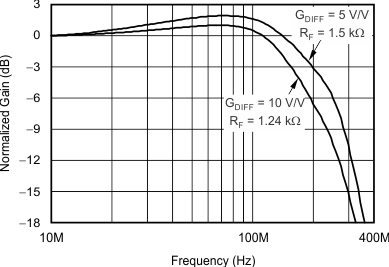
| VO = 2 VPP |
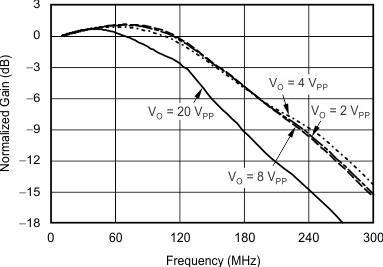
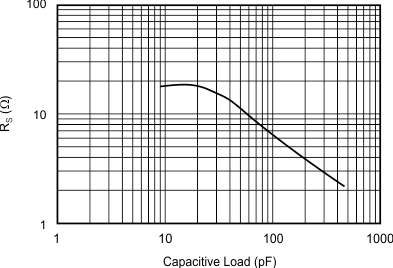
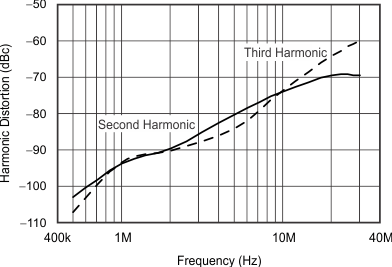
| VO = 2 VPP |
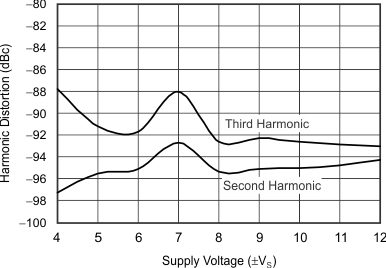
| VO = 2 VPP, f = 1 MHz |
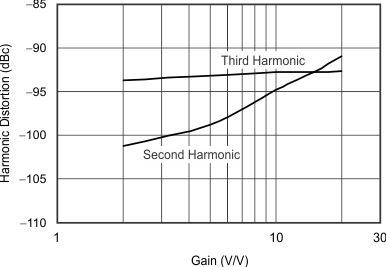
| VO = 2 VPP, f = 1 MHz |
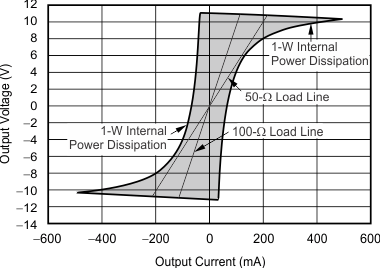
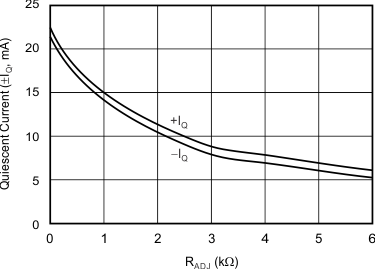
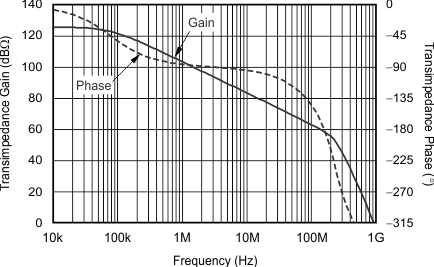
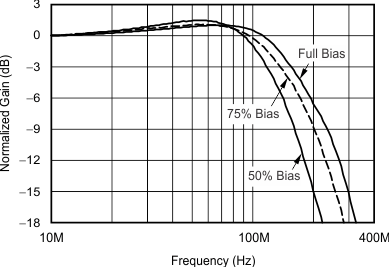
| VO = 2 VPP |
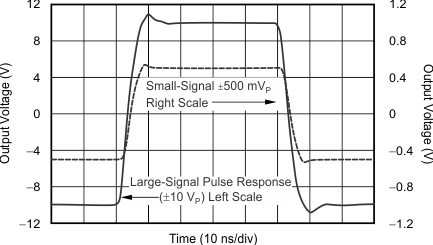
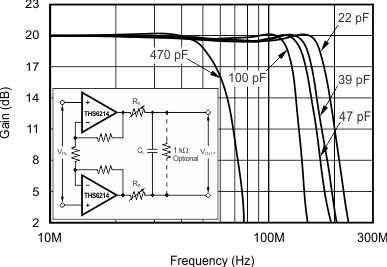
| RS optimized for 100% bias |
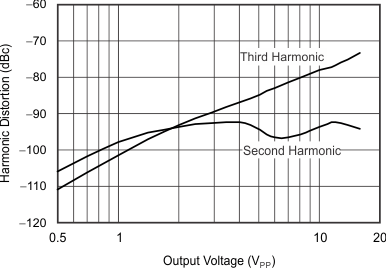
| f = 1 MHz |
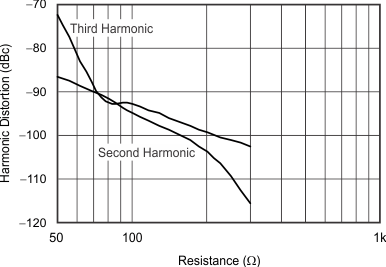
| VO = 2 VPP, f = 1 MHz |
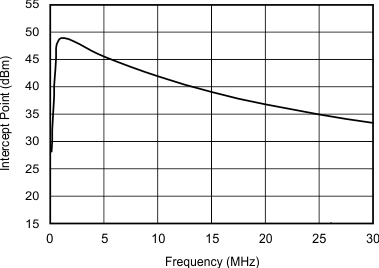
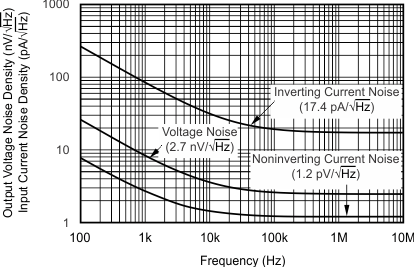
| Voltage and current noise contributing to differential noise |
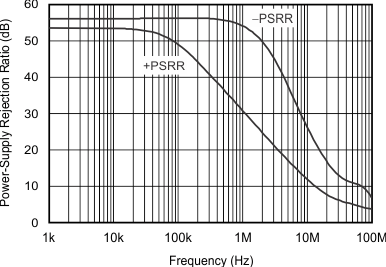
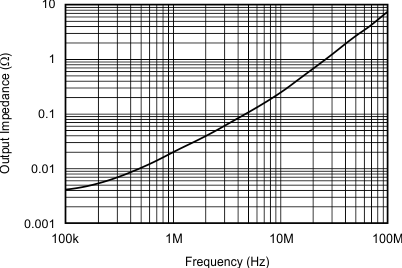
6.9 Typical Characteristics: VS = ±12 V, Mid Bias
at TA = 25°C, GDIFF = 10 V/V, GCM = 1 V/V, RADJ = 0 Ω, RF = 1.24 kΩ, and RL = 100 Ω (unless otherwise noted)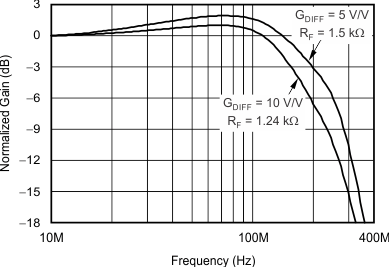
| VO = 2 VPP |
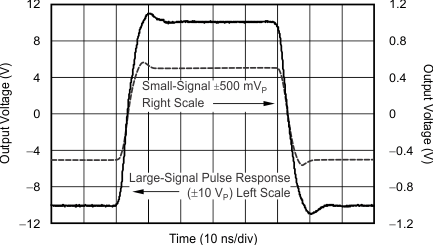
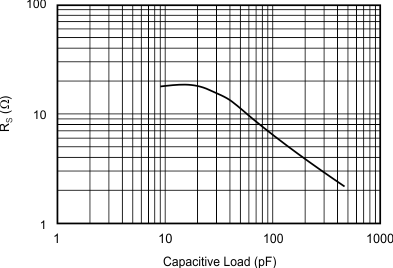
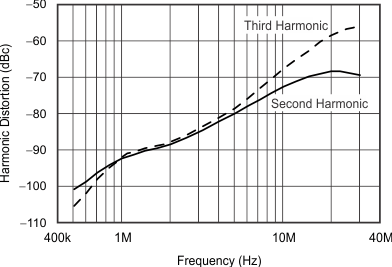
| VO = 2 VPP |
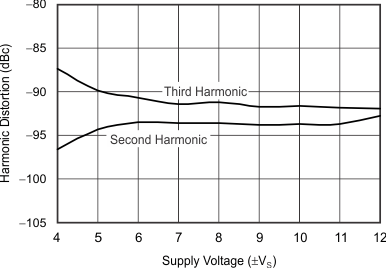
| VO = 2 VPP, f = 1 MHz |
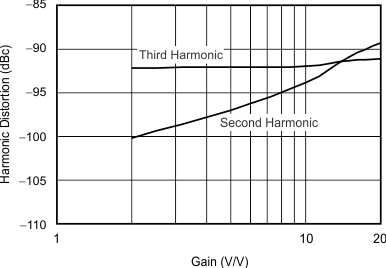
| VO = 2 VPP, f = 1 MHz |
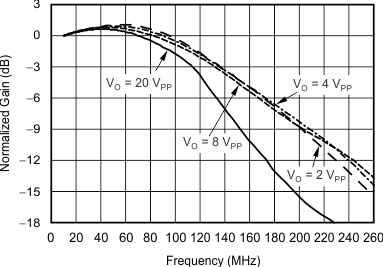
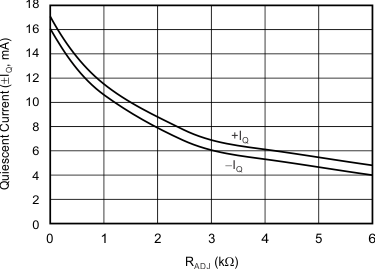
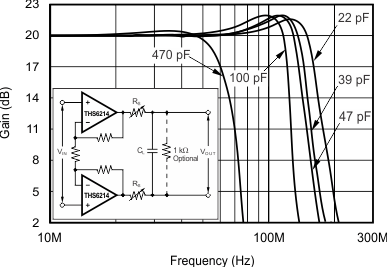
| RS optimized for 100% bias |
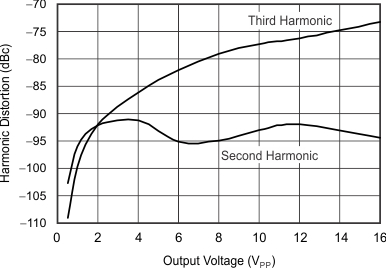
| f = 1 MHz |
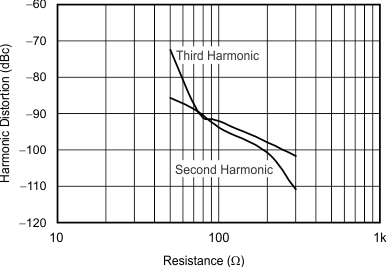
| VO = 2 VPP, f = 1 MHz |
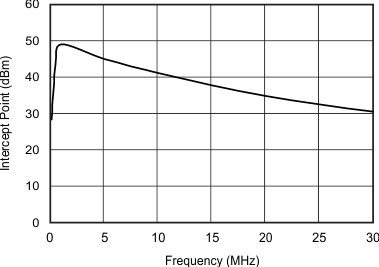
6.10 Typical Characteristics: VS = ±12 V, Low Bias
at TA = 25°C, GDIFF = 10 V/V, GCM = 1 V/V, RADJ = 0 Ω, RF = 1.24 kΩ, and RL = 100 Ω (unless otherwise noted)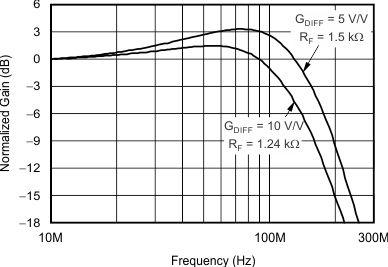
| VO = 2 VPP |
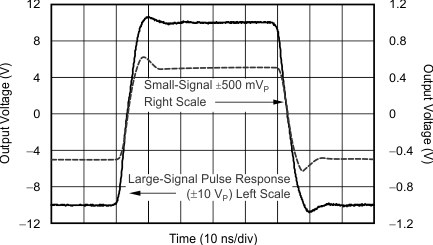
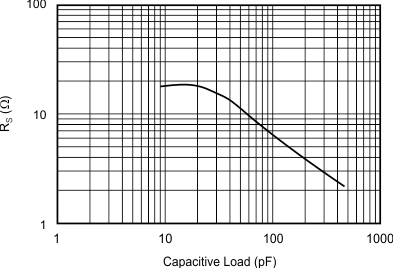
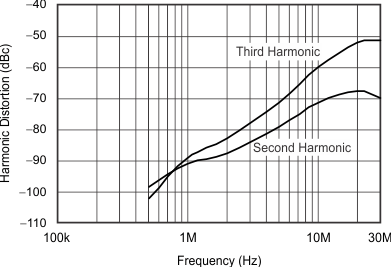
| VO = 2 VPP |
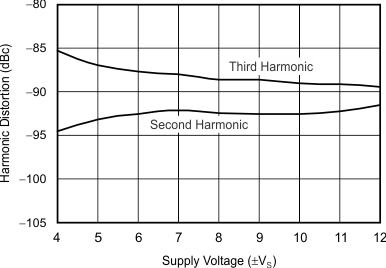
| VO = 2 VPP, f = 1 MHz |
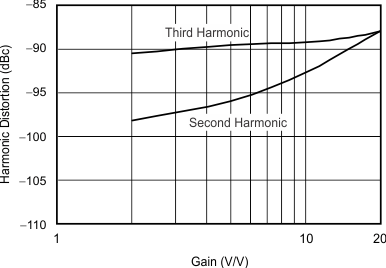
| VO = 2 VPP, f = 1 MHz |
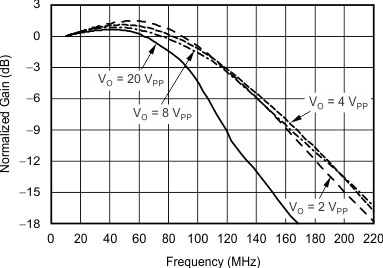
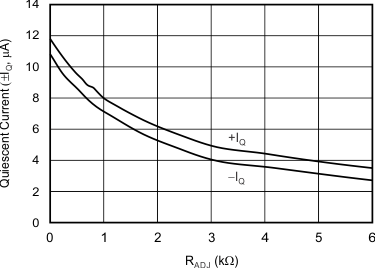
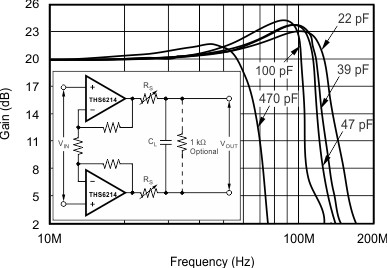
| RS optimized for 100% bias |
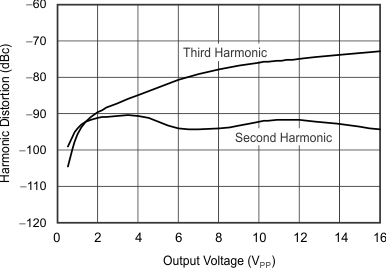
| f = 1 MHz |
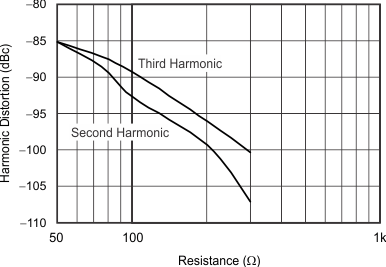
| VO = 2 VPP, f = 1 MHz |
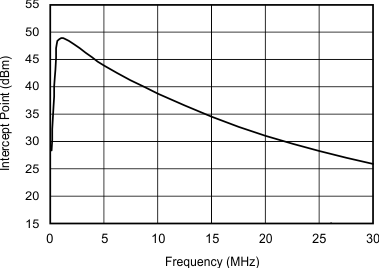
6.11 Typical Characteristics: VS = ±6 V, Full Bias
at TA = 25°C, GDIFF = 5 V/V, GCM = 1 V/V, RADJ = 0 Ω, RF = 1.82 kΩ, and RL = 100 Ω (unless otherwise noted)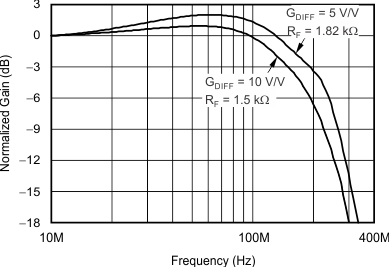
| VO = 2 VPP |
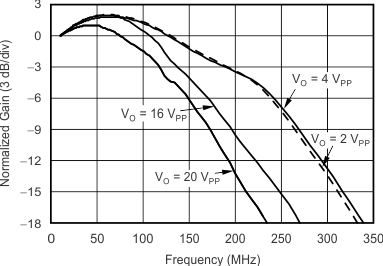
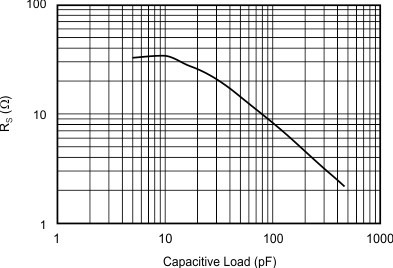
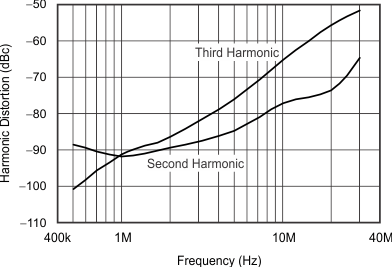
| VO = 2 VPP |
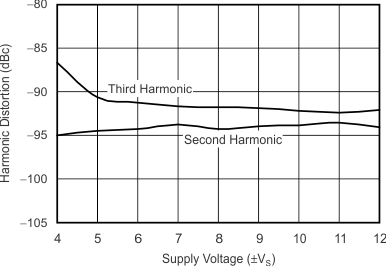
| VO = 2 VPP, f = 1 MHz |
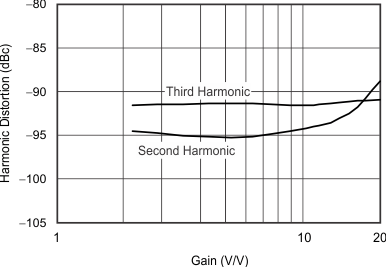
| VO = 2 VPP, f = 1 MHz |
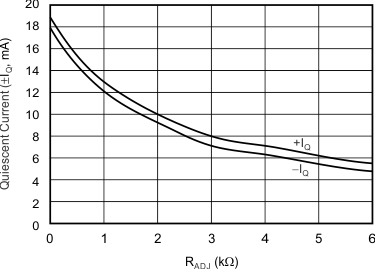
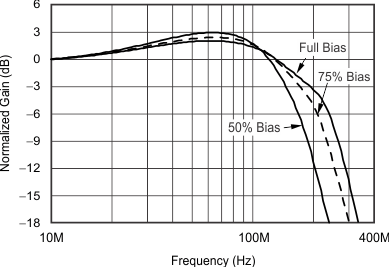
| VO = 2 VPP |
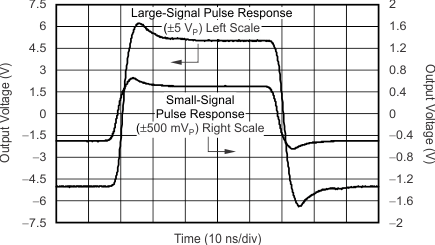
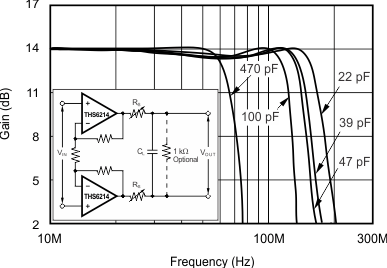
| RS optimized for 100% bias |
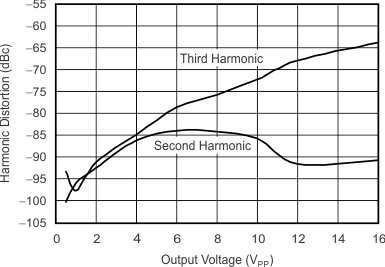
| VO = 2 VPP, f = 1 MHz |
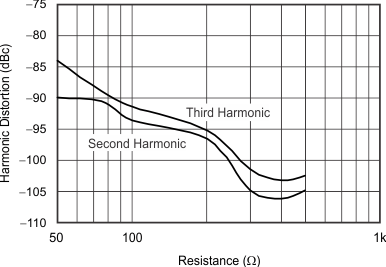
| VO = 2 VPP, f = 1 MHz |
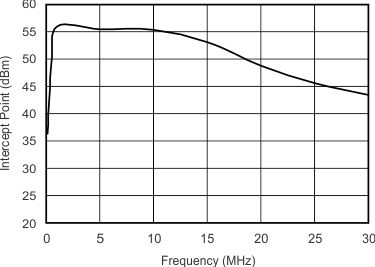
6.12 Typical Characteristics: VS = ±6 V, Mid Bias
at TA = 25°C, GDIFF = 5 V/V, GCM = 1 V/V, RADJ = 0 Ω, RF = 1.82 kΩ, and RL = 100 Ω (unless otherwise noted)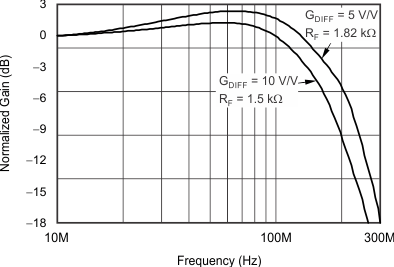
| VO = 2 VPP |
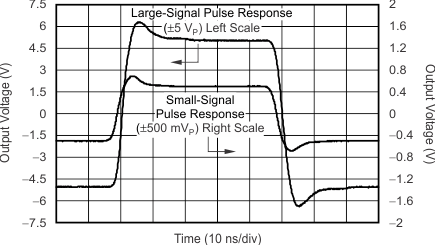
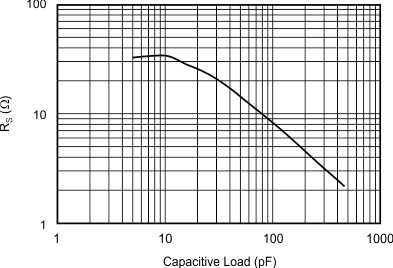
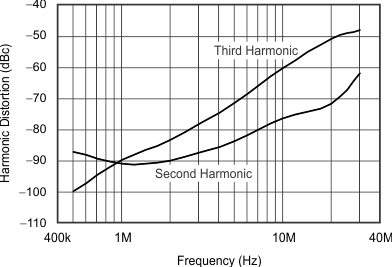
| VO = 2 VPP |
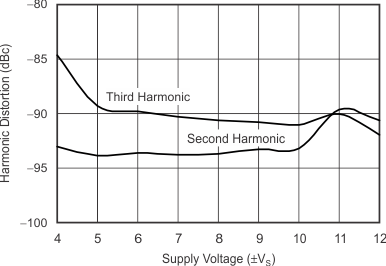
| VO = 2 VPP, f = 1 MHz |
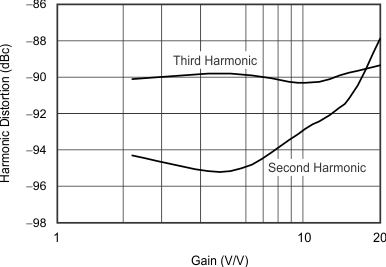
| VO = 2 VPP, f = 1 MHz |
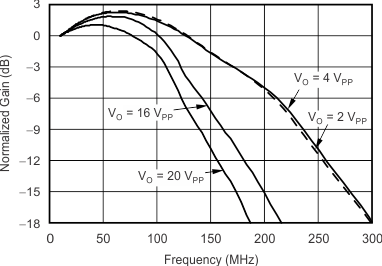
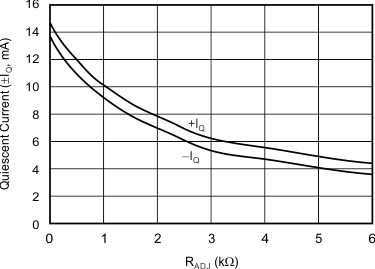
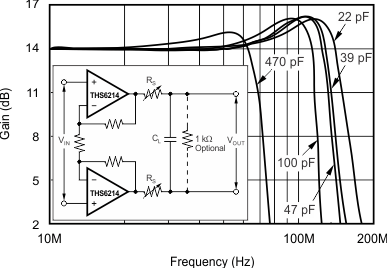
| RS optimized for 100% bias |
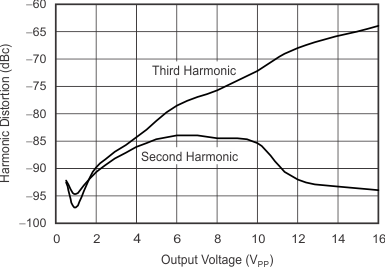
| f = 1 MHz |
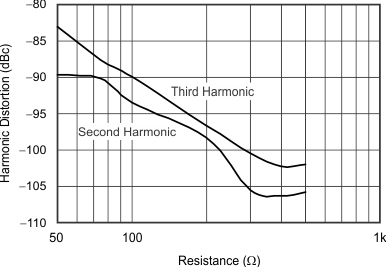
| VO = 2 VPP, f = 1 MHz |
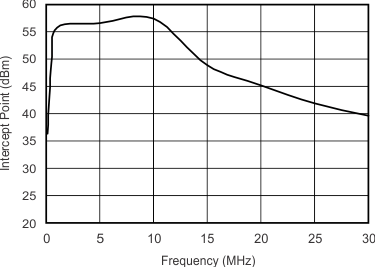
6.13 Typical Characteristics: VS = ±6 V, Low Bias
at TA = 25°C, GDIFF = 5 V/V, GCM = 1 V/V, RADJ = 0 Ω, RF = 1.82 kΩ, and RL = 100 Ω (unless otherwise noted)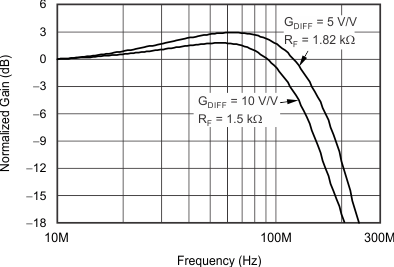
| VO = 2 VPP |
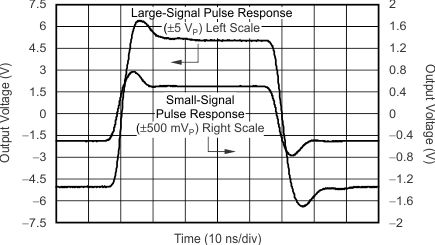
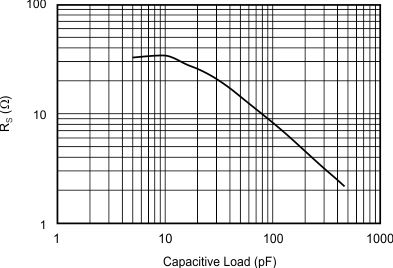
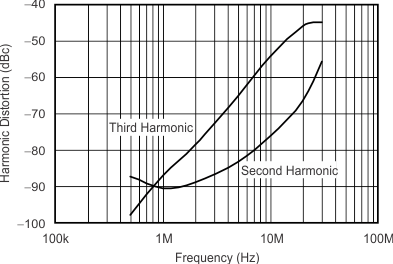
| VO = 2 VPP |
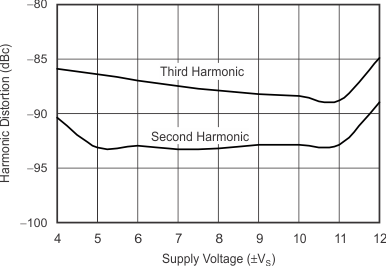
| VO = 2 VPP, f = 1 MHz |
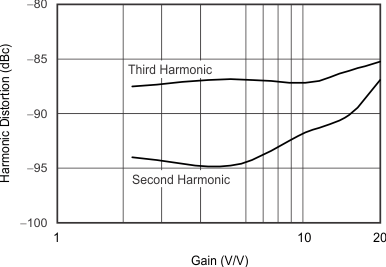
| VO = 2 VPP, f = 1 MHz |
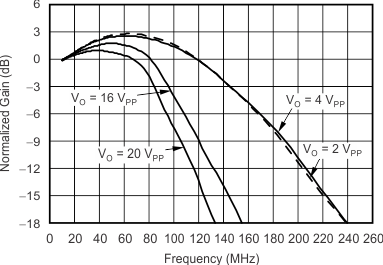
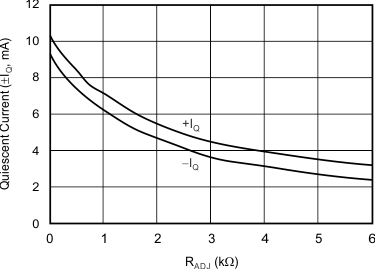
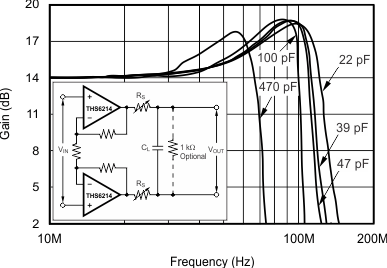
| RS optimized for 100% bias |
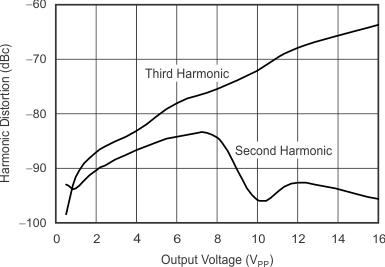
| f = 1 MHz |
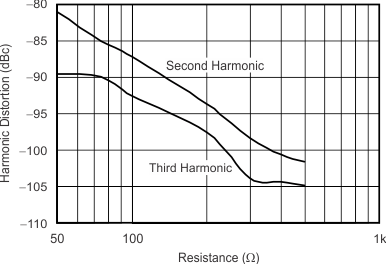
| VO = 2 VPP, f = 1 MHz |
